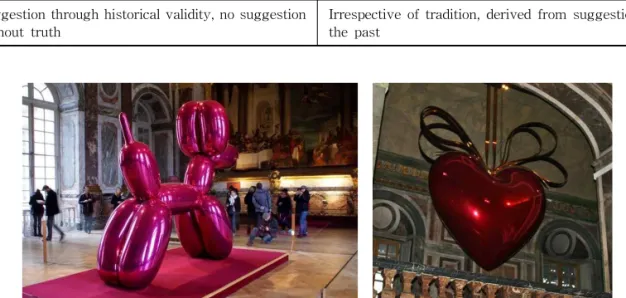1. INTRODUCTION
Many cultural contents have been born and newly changed due to the expansion of mass con- suming society and the multimedia era. However, most of the cultures are kitschy and the life of modern people is kitschy. Kitsch is low quality art and it can be referred to as work of art or an object which is low-brow style and has popular appeal.
Nisku mentioned that talking about the freedom from kitsch and the outside of kitsch is as hard as talking about outside of capitalism. Hence, studying kitsch is about researching modern peo- ple’s life and its way of expression.[1]
It is hard to imagine living without media in the
modern society and the media has been closely in- tertwined with people’s life. The “Webtoon” is one of the fasted growing media and it has more ex- panding subscribers than comic books. It means that a new kitschy cultural contents have been built as a way of escaping from an ordinary life.
Various forms of digital cartoons have appeared through popularization of Internet PC in mid-to- late 1990s, digitalization of analog contents and be- ing able to see offline contents online. The early stage of webtoon consisted of simple sections which were created by anonymous netizens and it had been spread via personal webpages, internet groups and the message boards in popular web- sites. In May 2014, there were over 1,200 webtoons
A Study on Kitschy Characteristics and its Consumers of Webtoon
Lee Eunkoung
†, Choi Myoungsik
††, Kim Cheeyong
†††ABSTRACT
Most of cultural area which people enjoy and consume is kitsch culture, though the culture is barely acknowledged. In this multimedia era, people create, publish and enjoy contents of 'webtoon(web+
cartoon)', which is relatively faster and more convenient to enjoy comparing to published cartoon.
Contrarily to its physical growth, the webtoon shows difficulty in advancing with other genres, is full of irritative factors and contents, and has tough time to become more sophisticated one. This study derived characteristics of kitsch in webtoon, suggested the way of webtoon as an art by analyzing conditions and usage motivation of webtoon. The conditions of kitsch are uniformity of mass consumption, popular vein, catharsis, vicarious satisfaction, immediate feedback-requiring image flood, and reproduction of techniques. The usage motivations of webtoon are studied as pursuit of information, entertainment, relaxation, socialization, convenience, and effectiveness. Usage motivation factors in webtoon and kitsch culture are almost identical. Contrary to its past of being underestimated and vulgarly considered, kitsch is acknowledged as an 'kitsch art'. By studying the process of becoming an art, the study has its purpose to suggest the experimental and developing way to make webtoon be acknowledged as 'webtoon art'.
Key words: Webtoon, Kitsch, Kitsch Art, Multi Media, Design, Consumers of Webtoon
※ Corresponding Author : Kim Cheeyong, Address:
(614-714) 176 Eumgwang-ro, Jin-gu, Busan city, Korea, TEL : +82-10-4584-4036, FAX : +82-51-890-2265, E-mail
: kimchee@deu.ac.kr
Receipt date : Jun. 11, 2015, Revision date : Jul. 14, 2015 Approval date : Jul. 17, 2015
†††
Major of Game Visual Engineering, Dong-Eui University (mapya@deu.ac.kr)
†††
Dept. of Formative Arts Design Graduate School Kounghee University (choims2020@hanmail.net)
†††


